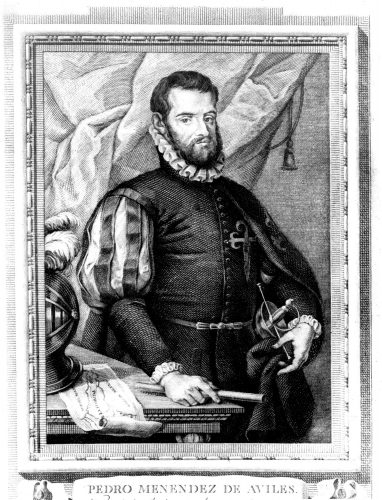Beginning early in 1566, Florida’s founder Pedro Menéndez de Avilés embarked on a far-reaching strategy to bring the native peoples of South Florida into his new colony.

With the colony’s hub at St. Augustine (in the territory of the agricultural Timucuan people of northern Florida), and its primary maritime connection to the rest of the Spanish colonial empire in Havana, Cuba, South Florida’s non-agricultural chiefdoms were sandwiched in the middle, and represented a pivotal area for Menéndez’s colonial plan. Within a year, Spanish garrisons had been placed at forts in Calos (on Mound Key), Tocobaga (in Tampa Bay), and Tequesta (in Miami), and perhaps 30,000 Indian people were nominally under Spanish control.
By January, 1568, the Tocobaga and Tequesta forts had been overrun and abandoned, and by June, 1569, the last garrison had been withdrawn from Calusa territory. Jesuit missionaries were relocated to Georgia and South Carolina, and Spain relinquished control of South Florida to its natives. Only a handful of European visits are documented for this region over the next two centuries.
In January, 1573, just a year and a half before his death in Spain, Menéndez proposed a truly radical change in strategy for South Florida, one which reflected his complete loss of hope for controlling its native peoples. He lamented that “although all the Indians from the Mosquito River [Mosquito Inlet] at the beginning of the Bahama Channel down to the Martyrs [Florida Keys], and returning up to Tocobaga Bay [Tampa Bay], have been approached in great friendship, and have been given many gifts and brought many times to Havana and returned to their lands, and have rendered obedience to His Majesty, they have many times ruptured the peace, killing many Christians, and they have been pardoned, and despite everything they have not taken advantage of this… I have established peace with them three times, and they have broken it.” Describing details of these acts, Menéndez proposed that “from now on, in order to protect the service of God our lord, and of His Majesty, it is suitable…that war be waged on them with all rigor, in blood and fire, and that those who are taken alive can be sold as slaves, removing them from the land and carrying them to the neighboring islands of Cuba, Santo Domingo, and Puerto Rico, because in this manner…it will remain clean and depopulated…and it will be a great example and fear for the friendly Indians who maintain and fulfill our friendship.”
Importantly, the Spanish crown denied Menéndez’s request to enslave the South Florida Indians, and instead proposed that Spanish soldiers “go into the interior and apprehend all those guilty for the murders and sacrifices that have been committed against Christians under pretense of peace and friendship” but that the rest “should be brought to the islands of Cuba, Hispaniola, and Puerto Rico and turned over to the justices of those islands so that they are distributed among the people that seem most suitable to instruct them in government, and to become Christians, or to give them places to make their villages with the government of people who will occupy them in labor, and to have regulation and catechesis.” In all cases, however, the Spanish crown commanded “that neither one nor the other should be slaves.” Although this plan was never implemented, it demonstrates staunch legal support for the prohibition of any Indian slavery in Spanish colonies after the early sixteenth century.
Finally, it is a curious coincidence that after nearly a century and a half of near-total isolation, between 1704 and 1760 several hundred South Florida Indian refugees from English-sponsored enslavement were voluntarily transported to Cuba and resettled at a location on Havana Bay just opposite downtown Havana, where they established a community and were sent missionaries, just as proposed in the official response to Menéndez’s 1573 proposal. The fierce independence and isolationism of South Florida’s native peoples may have delayed the process for many generations, but their ultimate fate was indeed resettlement in Cuba, where their descendants may yet remain to be discovered among modern populations.
This article was taken from the Friends of the Randell Research Center Newsletter Vol 6, No. 2. June 2007.